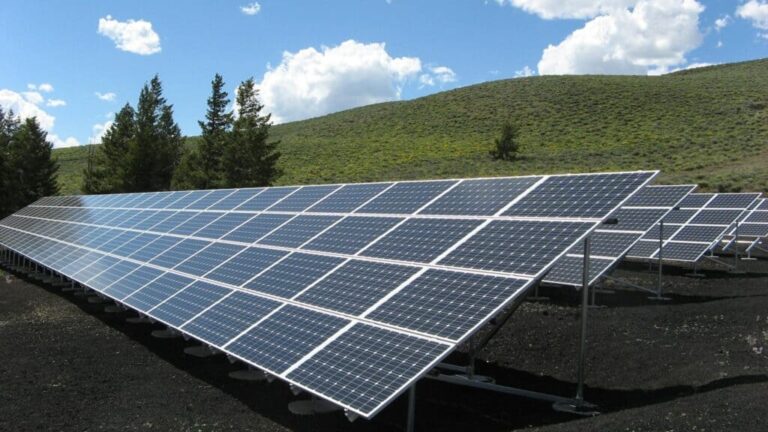Innovations in Solar Panel Technology: What’s Next for Green Energy?
Solar panel technology has revolutionized the way we harness energy from the sun, offering a renewable and sustainable alternative to traditional fossil fuels. As the world increasingly turns its focus towards green energy solutions, advancements in solar panel technology continue to drive innovation and improve efficiency. In this comprehensive guide, we’ll explore the latest innovations in solar panel technology and what they mean for the future of green energy.
Define the Technology
Solar panels, also known as photovoltaic (PV) panels, are devices that convert sunlight into electricity through the photovoltaic effect. They consist of multiple solar cells made of semiconductor materials, such as silicon, which absorb sunlight and generate direct current (DC) electricity.
Relevance and Importance
The importance of solar panel technology lies in its ability to provide clean and sustainable energy without relying on finite resources or emitting harmful greenhouse gases. With the growing concern over climate change and environmental degradation, solar energy offers a viable solution to reduce reliance on fossil fuels and mitigate the impact of global warming.
Technical Specifications
Understanding the technical specifications of solar panels is essential for evaluating their performance and efficiency.
Solar Cell Efficiency
Solar cell efficiency refers to the percentage of sunlight that a solar cell can convert into electricity. Higher efficiency solar cells produce more electricity for a given amount of sunlight, resulting in greater overall energy generation.
Panel Size and Wattage
The size and wattage of a solar panel determine its power output. Larger panels with higher wattage ratings can generate more electricity, making them suitable for larger-scale installations or applications with high energy demands.
Material Composition
The material composition of solar panels influences their durability, efficiency, and cost. Common materials include monocrystalline silicon, polycrystalline silicon, and thin-film technologies such as cadmium telluride (CdTe) and copper indium gallium selenide (CIGS).
Inverter Efficiency
Inverters convert the DC electricity generated by solar panels into alternating current (AC) electricity suitable for use in homes and businesses. Inverter efficiency affects overall system performance and energy yield.
Applications
Solar panel technology has a wide range of applications across various industries and settings.
Residential Solar Power
Residential solar power systems allow homeowners to generate their own electricity from sunlight, reducing reliance on the grid and lowering utility bills. Rooftop solar installations are common in residential settings, providing clean and renewable energy for households.
Commercial and Industrial Solar
Commercial and industrial facilities can benefit from solar energy by offsetting electricity costs and reducing their carbon footprint. Large-scale solar installations on commercial buildings, warehouses, and factories contribute to sustainable business practices and environmental stewardship.
Off-Grid Solar Solutions
Off-grid solar solutions provide electricity to remote or off-grid locations where traditional utility infrastructure is unavailable or impractical. These systems often incorporate battery storage to store excess energy for use during periods of low sunlight.
Solar Farms
Solar farms, also known as solar parks or solar power plants, are large-scale installations consisting of multiple solar panels arranged in arrays. These utility-scale projects generate electricity for distribution to the grid, contributing to renewable energy goals and reducing reliance on fossil fuels.
Benefits
The adoption of solar panel technology offers numerous benefits for individuals, businesses, and the environment.
Clean and Renewable Energy
Solar energy is abundant, clean, and renewable, making it an environmentally friendly alternative to fossil fuels. By harnessing sunlight, solar panels produce electricity without emitting greenhouse gases or harmful pollutants.
Cost Savings
Investing in solar panels can lead to significant cost savings over time, as homeowners and businesses reduce their reliance on expensive utility electricity. With incentives such as tax credits and rebates, the upfront cost of solar installations can be offset, further increasing the financial benefits.
Energy Independence
Solar power provides energy independence by allowing individuals and businesses to generate their own electricity onsite. This reduces dependence on external energy sources and insulates against fluctuating energy prices.
Job Creation
The solar industry has become a significant source of employment, creating jobs in manufacturing, installation, maintenance, and research and development. As demand for solar energy continues to grow, so too does the need for skilled workers in the renewable energy sector.
Challenges and Limitations
Despite its many benefits, solar panel technology also faces several challenges and limitations.
Intermittent Nature
Solar energy is inherently intermittent, as it depends on sunlight for generation. Cloud cover, inclement weather, and nighttime hours can impact energy production, requiring backup storage or supplementary energy sources.
Energy Storage
Energy storage is a critical component of solar power systems, allowing excess energy generated during peak sunlight hours to be stored for use when sunlight is unavailable. Battery storage technologies such as lithium-ion batteries are commonly used for this purpose but can add to the overall cost of solar installations.
Land Use and Aesthetics
Large-scale solar installations, such as solar farms, require significant land area for deployment. This can lead to conflicts over land use, particularly in densely populated areas or environmentally sensitive regions. Additionally, some individuals may object to the aesthetic impact of solar panels on landscapes or scenic views.
Environmental Concerns
While solar energy itself is clean and renewable, the manufacturing and disposal of solar panels can have environmental impacts. The production process may involve the use of toxic chemicals, and end-of-life disposal presents challenges for recycling and waste management.
Latest Innovations
Advancements in solar panel technology continue to drive innovation and improve efficiency, opening up new possibilities for renewable energy generation.
Perovskite Solar Cells
Perovskite solar cells are a promising alternative to traditional silicon-based solar cells, offering higher efficiency and lower production costs. Researchers are exploring ways to scale up production and improve stability for commercial deployment.
Bifacial Solar Panels
Bifacial solar panels can capture sunlight from both the front and back surfaces, increasing energy yield by up to 20%. These panels are particularly well-suited for installations with reflective surfaces, such as snow or white roofs.
Solar Paint
Solar paint is a novel technology that allows surfaces to generate electricity from sunlight. By incorporating photovoltaic materials into paint formulations, researchers aim to create versatile and customizable solar energy solutions for buildings and infrastructure.
Transparent Solar Panels
Transparent solar panels are designed to replace conventional windows and glass facades while still allowing natural light to enter buildings. These see-through solar panels can generate electricity without obstructing views or altering architectural aesthetics.
Future Prospects
The future of solar panel technology holds immense potential for further innovation and widespread adoption.
Increased Efficiency
Continued research and development efforts aim to increase the efficiency of solar panels, allowing for greater energy generation from sunlight. Breakthroughs in materials science and manufacturing processes may lead to significant efficiency gains in the coming years.
Energy Storage Solutions
Advancements in energy storage technologies will play a crucial role in maximizing the benefits of solar energy. Improved battery technologies, along with innovative storage solutions such as pumped hydroelectric storage and thermal storage, will enhance grid stability and reliability.
Integration with Smart Grids
The integration of solar power systems with smart grids enables more efficient energy management and distribution. By leveraging real-time data and predictive analytics, smart grid technologies optimize energy usage, reduce waste, and support renewable energy integration.
Solar-Powered Transportation
Solar energy can also be harnessed to power electric vehicles (EVs) and public transportation systems, reducing reliance on fossil fuels and lowering greenhouse gas emissions. Solar-powered EV charging stations and solar panels integrated into roadways offer sustainable solutions for transportation infrastructure, paving the way for cleaner and greener mobility options.
Comparative Analysis
Comparing solar panel technology with other renewable energy sources provides valuable insights into its strengths and limitations.
Solar vs. Wind Power
Solar and wind power are the two leading sources of renewable energy, each with its own advantages and drawbacks. While solar energy is more predictable and widely applicable, wind power offers higher energy density and can be more cost-effective in certain locations.
Solar vs. Hydroelectric Power
Hydroelectric power relies on the flow of water to generate electricity, making it highly reliable but limited by geographic constraints. Solar energy, on the other hand, is more versatile and can be deployed in a wider range of locations, albeit with intermittent generation patterns.
Solar vs. Fossil Fuels
Compared to fossil fuels such as coal, oil, and natural gas, solar energy offers a cleaner and more sustainable alternative. Solar power produces no greenhouse gas emissions during operation, reducing environmental impact and mitigating the effects of climate change.
Solar vs. Nuclear Power
Nuclear power provides a low-carbon source of electricity but comes with significant safety and environmental risks, including the potential for accidents and radioactive waste disposal. Solar energy poses fewer safety concerns and has no long-term waste management issues, making it a safer and more environmentally friendly option.
User Guides or Tutorials
Understanding how to effectively harness solar energy is essential for maximizing its benefits and optimizing system performance.
Solar Panel Installation
Proper installation is critical for the efficiency and longevity of solar panel systems. Installers must consider factors such as roof orientation, tilt angle, shading, and structural integrity to ensure optimal performance.
Maintenance and Cleaning
Regular maintenance and cleaning help to keep solar panels operating at peak efficiency. This includes removing debris, dirt, and snow from the panels, checking for damage or defects, and monitoring energy production levels.
Monitoring and Optimization
Monitoring energy production and system performance allows homeowners and businesses to identify potential issues and optimize energy output. Online monitoring platforms provide real-time data on energy generation, consumption, and savings, helping users make informed decisions about their solar investments.
Safety Guidelines
Safety should always be a top priority when working with solar panel systems. Installers and homeowners must follow safety guidelines and regulations to prevent accidents, electric shocks, and fire hazards.
Conclusion
Innovations in solar panel technology are driving the transition to a cleaner, more sustainable energy future. By harnessing the power of the sun, we can reduce reliance on fossil fuels, mitigate climate change, and create a brighter tomorrow for generations to come.




